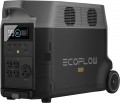In box
- Charging station. Portable charging stations are powerful “power banks” that can establish autonomous operation of an arsenal of home appliances, organize the supply of electricity in the country, during road trips or forays into nature, and charge many mobile phones overnight. Charging stations differ from traditional UPSs in their automatic operating modes. The power of such devices varies widely from approximately 100 to 3600 W. Mobile stations are charged from a regular household outlet, solar panels, car cigarette lighter socket, generator, or via a USB type C port with Power Delivery support. As for the configuration, the charging station can be supplied either by itself or
additionally with a solar panel,
battery pack,
inverter or
inverter and solar panel. In addition to the built-in battery of the charging station, you can also purchase
a battery pack separately.
— Battery pack. An additional battery pack to increase the total energy capacity of the charging station and, as a result, extend the period of autonomous power supply to consumers. Often, battery packs are produced for a specific model or family of charging stations in accordance with the dimensions of the device. Their design, as a rule, is stacked: a block with an additional battery is connected to the charging station f
...rom below or from the side.
— Charging station with battery pack. The standard configuration of such charging stations includes an additional battery pack, which allows you to increase the energy intensity of the device. Note that, if necessary, the additional battery can be easily detached from the charging station and it can be used without an external battery.
— Charging station with solar panel. Charging stations with a complete solar panel suggest the possibility of replenishing energy reserves in battery cells from the celestial body. Out of the box, they come with a folding solar panel that can be deployed on a sunny lawn and charge the device when there is no electricity in the outlet. Depending on the power of the charging station and solar panel, as well as weather conditions and daylight hours, the charging procedure can last from several hours to a full daylight hours (or even more).
- With an inverter. The delivery set of such charging stations includes an inverter, which is used to convert direct power energy from solar panels into alternating power for domestic needs. Note that in this case it is assumed that there is only one inverter - solar panels for charging a portable power station from the rays of the heavenly body will need to be purchased separately. Charging stations with an inverter and a solar panel are also available (see below).
— With inverter and solar panel. Advanced configuration, which implies the presence of a charging station, one or more solar panels and an inverter for converting energy from them. In this form, the portable power station impresses with its energy independence - it can be charged directly from the sun’s rays, even during a long absence of electricity in the outlets, and the charging station is ready for this right out of the box.Rated power
Power that a device can consistently produce for an indefinitely long time without any unpleasant consequences. For normal operation of the charging station, the rated power must be at least 15 - 20% higher than the total power of all devices simultaneously connected to it.
Peak power
Some electrical appliances (in particular, units with electric motors - refrigerators, air conditioners, etc.) consume significantly more energy at startup than after reaching the operating mode. For such a load, the peak power of the charging station must be taken into account - its indicator must be higher than the starting power of the load.
Output waveform
Line shape on a graph of the voltage output from a charging station. The quality of power provided by the device depends on this parameter.
—
Sine wave (PSW — Pure Sine Wave). The signal is in the form of a smooth wave without sharp steps, maximally corresponding to the parameters of conventional AC networks. Charging stations with this output signal form can be used for almost any type of load, incl. for powering sensitive electronics that place high demands on the quality of the input voltage.
— Modified sine wave. In a signal similar to a sine wave, the waves on the graph are formed not by smooth lines, but by characteristic “steps” (i.e., jerks). An approximated sine wave is not suitable for powering sensitive electronics, but in general there are not so many such devices in the total number, and circuits with a modified sine wave do not require the creation of expensive and complex technical solutions. As a result, they are cheaper.
UPS function
Charging stations with
UPS function switch consumers to backup power from their own battery, acting as an uninterruptible power supply. In comparison with full-fledged UPSs, switching does not occur instantly, but with a certain delay (about 10-30 ms). To use this function correctly, you must first study the instructions for the charging station, which often describes the correct procedure for connecting the intended consumer devices.
Sockets (230 V)
Total number of outlets with output voltage. This is, in fact, the number of devices that can be simultaneously connected to the charging station without the use of splitters, extension cords and carriers. Accordingly, weaker charging stations have
one or
two sockets in their submission.
Powerful charging stations already have three or
more sockets “on board”.
USB A
Full-size USB A connectors are popular in computer technology, they are standardly used in adapter chargers for 230 V household networks and 12 V auto sockets. In charging stations, such outlets are widely used for charging gadgets.
- The total number of such ports can be very diverse (
1 USB,
2 connectors,
3 ports and even
4), since it allows you to connect for charging, and in some cases for power, various low-power devices -
smartphones,
tablets,
power banks,
lamps, etc. .
- The strength of the power. The maximum power output through the USB A connector to the device being charged. Note that different ports of the charging station can output different power (for example, 1.5 A and 2.1 A). In this case, the highest power strength is usually indicated.
— Power. The maximum
output power in watts (W) that the charging station is capable of delivering through the USB A connector to one charging device.
USB A (quick charge)
Full size
USB A ports with fast charging support. It allows you to charge your smartphone, tablet or other connected device much faster. The charging process takes place at increased power, and the current and voltage at each stage are regulated in such a way as to remain within the optimal values. However, it should be borne in mind that in our time there are many fast charging technologies and not all of them are compatible with each other.
- The strength of the current. The parameters of the current issued through the USB A fast charging connectors. Note that different voltage and current parameters can be output to different ports of the charging station. This item specifies the current values at a certain voltage (for example, 5 V / 3 A, 9 V / 2 A, 12 V / 1.5 A).
— Power. The maximum power in watts (W) that the charging station is capable of delivering through the USB A fast charging connector to one charging device. High output power allows you to speed up the charging process. However, the appropriate power must be supported by the device being charged - otherwise the speed of the process will be limited by the characteristics of the gadget.
USB C
USB type C ports are smaller than classic USBs, and they also have a convenient reversible design that allows you to connect the plug in either direction.
USB type C was originally designed to be able to implement various advanced features: increased power supply, fast charging technologies, etc.
Since the port is relatively new and quite powerful (there are
USB type C with a power of 60 W and even
100 W), the total number of such connectors is often limited to
1 port, less often
two).
- The strength of the power. The maximum power output through the USB type C connector to a charging device. Note that different ports of the charging station can output different power (for example, 1.5 A and 2.1 A). In this case, the highest power strength is usually indicated.
— Power. The maximum power in watts (W) that the charging station is capable of delivering to one rechargeable gadget. The high output power of the USB type C port allows you to speed up the charging process. However, the appropriate power must be supported by the device being charged - otherwise the speed of the process will be limited by the characteristics of the gadget.

